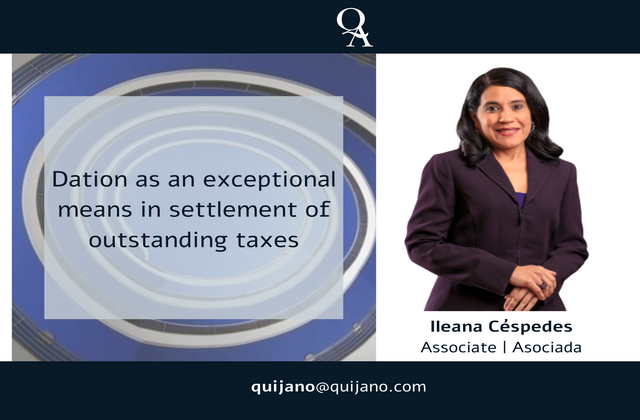Dation as an exceptional means in settlement of outstanding taxes

Dation in payment has been usually defined as the transfer of the property of an asset in settlement of outstanding debts. In other words, the debtor transfers an asset to the creditor and the creditor accepts it as payment in settlement of an obligation.
As a way to settle obligations, dation in payment is not a familiar procedure in Panamanian legislation, but it has been studied and commented by Panamanian and by foreign scholars. For instance, Dr. Narciso Garay, in Volume II of his Civil Law treatise, refers to dation in payment as follows:
“Dation in payment is the transfer of the property of an item which is not the one stipulated as due to be settled in compliance with an obligation, and which the creditor accepts as settlement. There is no specific rule or regulation, but it is accepted by virtue of two principles:
1º Because in Private Law, the parties may stipulate whatever does not infringe law, moral principles and public order.
2º Because legal provisions allow to impart it with its own juridical nature. Particularly article 1053 of the Civil Code interpreted “a contrario sensu”. Several scholars, such as Planiol, Ripert, Josserand, etc. have stated that the dation in payment is a novation by changing the object and that the new obligation is improperly fulfilled.
However, although there are no civil regulations for dation in payment, Article 68 of the Taxation Procedural Code of the Republic of Panama, which was approved by Law No. 76 of 2019, does provide for dation in payment in kind as an exceptional way to settle taxation obligations. It is understood that taxation includes taxes, fees and special contributions owed to the Nation as a consequence of a taxable fact stipulated by law.
In view of the above, by Resolution No. 201-5882 of the 2nd of July, 2021, established the dation in payment procedure to transfer real estate and chattel property as an exceptional way to pay for one’s own or for another individual’s taxes outstanding. In order to do so, the taxpayer or someone in her/his/its stead has to submit an application form to the General Directorate of Income Tax with the following data:
- The identity of the taxpayer and full personal data.
- A description of the motives for wanting to use dation in kind as payment of outstanding taxes.
This application must be submitted with the following documents, to wit:
- A formal proposition to make the exceptional payment in kind with the details of the asset or assets offered as full or partial payment of the taxes outstanding and the details of the offer proposed. Said proposal must be signed by the owner of the assets and by the individual who wishes to use this form of payment in the event that she/he/it is not the owner of the assets. Any signature must be authenticated by a Notary Public.
- A certificate issued by an Authorized Public Accountant as evidence that the individual making the proposal does not have enough liquidity to pay the amount outstanding on the date of the application.
- In the event that the proposal is being made by a legal entity, in addition to the Certificate of Existing of the legal entity issued by the Public Registry with the name of its Legal Representative, a copy of the minutes of the Assembly of Shareholders authorizing the transfer of the assets. In the event that the legal entity is not the owner of the asset to be transferred but a different legal entity, all of the above-mentioned documents related to the latter legal entity must be included.
- If the asset to be transferred is real estate, the proposal must be submitted with a Certificate issued by the Public Registry expressing the identity of the owner and a description of the asset as well as any registered encumbrances, if any. In the event that it is chattel property, evidence of ownership must be provided with the documents as well as a statement of the commercial value thereof.
Upon receipt of the application, the Department of Coercive Collection of the Commission of Payment in Kind, as the case may be, will request an appraisal of the chattel property or the real estate as an exceptional form of payment, it will analyze the application and issue a Report of Appraisal within a term of thirty (30) days. If the asset is real estate, the appraisal shall be conducted by the Ministry of Economy and Finance and the Office of the Comptroller General of the Republic.
Then, within the following ten (120) days, the Director General of Income shall proceed to issue a resolution in acceptance or refusal of the dation in payment in kind. If accepted, the assets shall be transferred to the Directorate of Immovable Property and the established value thereof shall be applied to the outstanding taxes of the taxpayer or the tax obligations of the individual or legal entity, including surcharge, interest, fines and condonations on account of tax amnesties computed until the date of actual payment.
If the asset of the dation is worth more than the taxes outstanding, the excess in value shall be credited to the taxpayer who requested the dation in payment.
The dation in payment in kind introduced in the Taxation Procedural Code is a way for taxpayers to willingly choose to pay their outstanding taxes in kind and avoid being submitted to a more complex and encompassing sequestration process.




